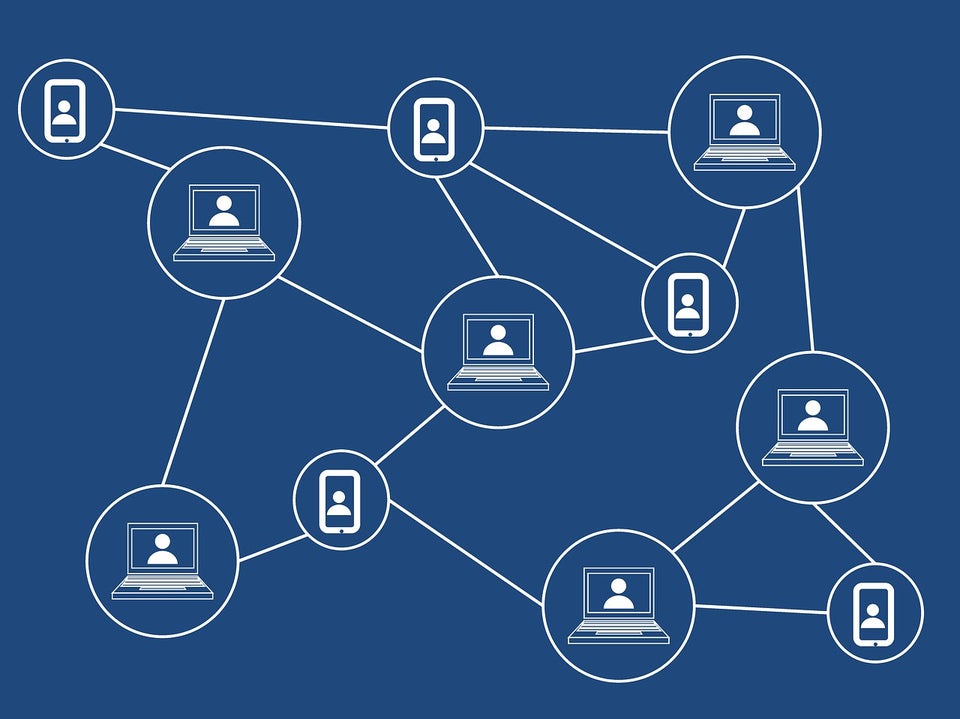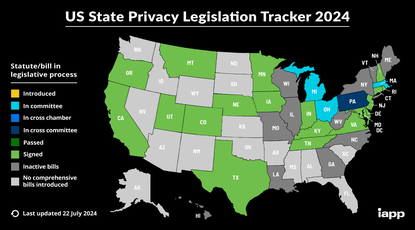What is a blockchain?
A blockchain is a continuously growing list of records, called blocks, which are linked and secured using cryptography. Each block typically contains a hash pointer as a link to a previous block, a timestamp and transaction data. By design, blockchains are inherently resistant to modification of the data. It is "an open, distributed ledger that can record transactions between two parties efficiently and in a verifiable and permanent way".
For use as a distributed ledger, a blockchain is typically managed by a peer-to-peer network collectively adhering to a protocol for validating new blocks. Once recorded, the data in any given block cannot be altered retroactively without the alteration of all subsequent blocks, which requires collusion of the network majority.
Blockchains are secure by design and are an example of a distributed computing system with high Byzantine fault tolerance. Decentralized consensus has therefore been achieved with a blockchain. This makes blockchains potentially suitable for the recording of events, medical records, and other records management activities, such as identity management, transaction processing, documenting provenance, food traceability or voting.
What are cryptocurrencies?
A cryptocurrency is a digital asset designed to work as a medium of exchange that uses cryptography to secure its transactions, to control the creation of additional units, and to verify the transfer of assets. Cryptocurrencies are classified as a subset of digital currencies and are also classified as a subset of alternative currencies and virtual currencies.
Bitcoin, created in 2009, was the first decentralized cryptocurrency. Since then, numerous other cryptocurrencies have been created. These are frequently called altcoins, as a blend of alternative coin. Bitcoin and its derivatives use decentralized control as opposed to centralized electronic money and central banking systems. The decentralized control is related to the use of bitcoin's blockchain transaction database in the role of a distributed ledger.
Blockchain Glossary: from A to Z
51% Attack
A 51% attack is when more than half of the computing power of a cryptocurrency network is controlled by a single entity or group. Controlling 51% of the computing power allows the attacking entity to issue conflicting transactions to harm the network.
Address
Cryptocurrency addresses are used to send or receive transactions on the network. An address usually consists of a string of alphanumeric characters.
ASIC
Short form for ‘Application Specific Integrated Circuit’. Often compared to GPUs, ASICs are circuits specifically designed for the purpose of mining cryptocurrencies.
Bitcoin
Bitcoin is the first decentralised, open source cryptocurrency that runs on a global peer to peer network, without the need for middlemen and a centralised issuer.
Block
Blocks are packages of data that carry permanently recorded data on the blockchain network.
Blockchain
A blockchain is a shared ledger where transactions are permanently recorded by appending blocks. The blockchain serves as a historical record of all transactions that ever occurred, from the genesis block to the latest block, hence the name blockchain.
Block Explorer
Block explorer is an online tool to view all transactions, past and current, on the blockchain. They provide useful information such as network hash rate and transaction growth.
Block Height
The number of blocks connected on the blockchain.
Block Reward
A form of incentive for the miner who successfully calculated the hash in a block during mining. Verification of transactions on the blockchain generates new coins in the process, and the miner is rewarded a portion of those.
Central Ledger
A ledger maintained by a central entity.
Confirmation
The successful act of hashing a transaction and adding it to the blockchain.
Consensus
Consensus is achieved when all participants of the network agree on the validity of the transactions, ensuring that the ledgers are exact copies of each other.
Cryptocurrency
Also known as tokens, cryptocurrencies are representations of digital assets.
Cryptographic Hash Function
Cryptographic hashes produce a fixed-size and unique hash value from variable-size transaction input. The SHA-256 computational algorithm is an example of a cryptographic hash.
Dapp
A decentralised application (Dapp) is an application that is open source, operates autonomously, has its data stored on a blockchain, incentivised in the form of cryptographic tokens and operates on a protocol that shows proof of value.
DAO
Decentralised Autonomous Organizations can be thought of as corporations that run without any human intervention and surrender all forms of control to an incorruptible set of business rules.
Distributed Ledger
Distributed ledgers are ledgers in which data is stored across a network of decentralized nodes. A distributed ledger does not have to have its own currency and may be permissioned and private.
Distributed Network
A type of network where processing power and data are spread over the nodes rather than having a centralised data centre.
Difficulty
This refers to how easily a data block of transaction information can be mined successfully.
Digital Signature
A digital code generated by public key encryption that is attached to an electronically transmitted document to verify its contents and the sender’s identity.
Double Spending
Double spending occurs when a sum of money is spent more than once.
Ethereum
Ethereum is a blockchain-based decentralised platform for apps that run smart contracts, and is aimed at solving issues associated with censorship, fraud and third party interference.
EVM
The Ethereum Virtual Machine (EVM) is a Turing complete virtual machine that allows anyone to execute arbitrary EVM Byte Code. Every Ethereum node runs on the EVM to maintain consensus across the blockchain.
Fork
Forks create an alternate version of the blockchain, leaving two blockchains to run simultaneously on different parts of the network.
Genesis Block
The first or first few blocks of a blockchain.
Hard Fork
A type of fork that renders previously invalid transactions valid, and vice versa. This type of fork requires all nodes and users to upgrade to the latest version of the protocol software.
Hash
The act of performing a hash function on the output data. This is used for confirming coin transactions.
Hash Rate
Measurement of performance for the mining rig is expressed in hashes per second.
Hybrid PoS/PoW
A hybrid PoS/PoW allows for both Proof of Stake and Proof of Work as consensus distribution algorithms on the network. In this method, a balance between miners and voters (holders) may be achieved, creating a system of community-based governance by both insiders (holders) and outsiders (miners).
Mining
Mining is the act of validating blockchain transactions. The necessity of validation warrants an incentive for the miners, usually in the form of coins. In this cryptocurrency boom, mining can be a lucrative business when done properly. By choosing the most efficient and suitable hardware and mining target, mining can produce a stable form of passive income.
Multi-Signature
Multi-signature addresses provide an added layer of security by requiring more than one key to authorize a transaction.
Node
A copy of the ledger operated by a participant of the blockchain network.
Oracles
Oracles work as a bridge between the real world and the blockchain by providing data to the smart contracts.
Peer to Peer
Peer to Peer (P2P) refers to the decentralized interactions between two parties or more in a highly-interconnected network. Participants of a P2P network deal directly with each other through a single mediation point.
Public Address
A public address is the cryptographic hash of a public key. They act as email addresses that can be published anywhere, unlike private keys.
Private Key
A private key is a string of data that allows you to access the tokens in a specific wallet. They act as passwords that are kept hidden from anyone but the owner of the address.
Proof of Stake
A consensus distribution algorithm that rewards earnings based on the number of coins you own or hold. The more you invest in the coin, the more you gain by mining with this protocol.
Proof of Work
A consensus distribution algorithm that requires an active role in mining data blocks, often consuming resources, such as electricity. The more ‘work’ you do or the more computational power you provide, the more coins you are rewarded with.
Scrypt
Scrypt is a type of cryptographic algorithm and is used by Litecoin. Compared to SHA256, this is quicker as it does not use up as much processing time.
SHA-256
SHA-256 is a cryptographic algorithm used by cryptocurrencies such as Bitcoin. However, it uses a lot of computing power and processing time, forcing miners to form mining pools to capture gains.
Smart Contracts
Smart contracts encode business rules in a programmable language onto the blockchain and are enforced by the participants of the network.
Soft Fork
A soft fork differs from a hard fork in that only previously valid transactions are made invalid. Since old nodes recognize the new blocks as valid, a soft fork is essentially backward-compatible. This type of fork requires most miners upgrading in order to enforce, while a hard fork requires all nodes to agree on the new version.
Solidity
Solidity is Ethereum’s programming language for developing smart contracts.
Testnet
A test blockchain used by developers to prevent expending assets on the main chain.
Transaction Block
A collection of transactions gathered into a block that can then be hashed and added to the blockchain.
Transaction Fee
All cryptocurrency transactions involve a small transaction fee. These transaction fees add up to account for the block reward that a miner receives when he successfully processes a block.
Turing Complete
Turing complete refers to the ability of a machine to perform calculations that any other programmable computer is capable of. An example of this is the Ethereum Virtual Machine (EVM).
Wallet
A file that houses private keys. It usually contains a software client which allows access to view and create transactions on a specific blockchain that the wallet is designed for.










